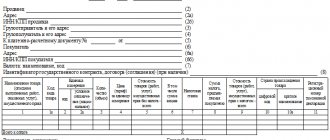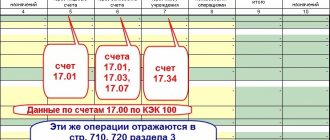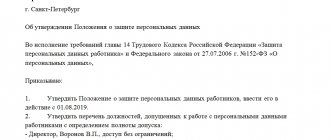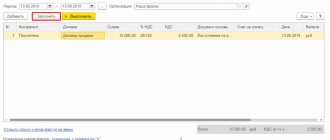About the transition to electronic invoices
In our fast-paced age, technical means and modern document formats help us not to drown in the huge flow of information and papers. In this regard, electronic invoices are becoming increasingly relevant for persons working with VAT.
IMPORTANT! The possibility of using electronic invoices is enshrined in clause 1 of Art. 169 NK. The new format of electronic invoices was approved by Order of the Federal Tax Service dated December 19, 2018 No. ММВ-7-15/ [email protected] , and the procedure for issuing them was approved by Order of the Ministry of Finance dated November 10, 2015 No. 174n.
To switch to using electronic invoices, you must:
- Agree with counterparties on the possibility of exchanging electronic invoices, having previously checked whether the parties have technical capabilities (clause 1.4 of Order No. 174n).
- Obtain a qualified electronic digital signature (letter of the Ministry of Finance of the Russian Federation dated September 12, 2016 No. 03-03-06/2/53176, Federal Tax Service of the Russian Federation dated May 19, 2016 No. SD-4-3/8904) at a certification center performing functions in accordance with the law “On electronic signature” dated 04/06/2011 No. 63-FZ.
- Conclude an agreement with one of the electronic document management operators (clause 1.3 of Order of the Ministry of Finance No. 174n, Order of the Federal Tax Service of Russia dated April 20, 2012 No. ММВ-7-6 / [email protected] ) - their list is posted on the Federal Tax Service website.
If all these steps are completed, you can start working with electronic invoices.
IS ESF Information System
IS ESF is a portal for issuing, receiving and processing electronic invoices in Kazakhstan, located at . This is a state system (operator is the State Revenue Committee of the Republic of Kazakhstan), so its use is free for users. In order to issue or receive invoices electronically, you must register and, if necessary, determine the list of employees who will work with the portal on behalf of the company.
Healthy
- In the article Who is required to issue invoices in electronic form (ESF), you can find out which taxpayers are already required to issue invoices in electronic form;
- In the PRO article, the deadlines for issuing invoices indicate during what period the ESF must be issued;
- The article PRO filling out electronic invoices describes the general principles for filling out electronic invoices.
To work with electronic invoices you can use:
- ;
- As well as the functions of the enterprise’s accounting system, if the program for maintaining accounting/tax accounting is integrated with the ESF IS using the API.
The State Revenue Committee provides taxpayers with the opportunity to debug the integration mechanisms of accounting programs. In the ESF IS test environment, you can try to issue/receive electronic invoices on behalf of a test company (without registering on the server), familiarize yourself with the main capabilities of the system and debug work with electronic documents.
Documents issued in the test environment have no legal force and are not used in control procedures by tax authorities. To log into the test server, test certificates are used, which are available on the State Revenue Committee portal.
Since April 1, 2020, a new module “Virtual Warehouse” has been added to the system.
Healthy
Read more about the “Virtual Warehouse” module in the materials:
- Virtual warehouse - what is it?;
- How to enter product balances into the Virtual Warehouse;
- Who is required to work in the Virtual Warehouse from April 1, 2018?
What is needed to work with the esf.gov.kz portal
First of all, you need to obtain registration certificates from the National Certification Center (EDS NCA RK), set up a web application at the user’s workplace and register the taxpayer in the electronic invoice information system. Of course, you need a stable Internet connection.
NCA RK keys are issued at the RK Population Service Centers (PSC). To register a legal entity (LLP, RGKP, GU, etc.) the following is required:
- key of a legal entity, issued to the first head of the enterprise (GOST);
- and the key of the individual of the first manager (RSA).
Individual entrepreneurs only need to obtain an electronic digital signature of an individual (a GOST key is not required).
Important!
Currently, the National Certification Center issues several types of registration certificates for legal entities: keys for the first manager, keys for employees with the right to sign, etc.
To register on the ESF portal, you need a set of keys for the first manager!
The list of documents required for registration of keys for a legal entity can be found or clarified by contacting the call center by phone 1414.
How to work with electronic invoices
It is possible to receive or send electronic invoices (ESF) only if all 3 parties (buyer, seller, EDI operator) can simultaneously participate in this, the technical means are in order and there is access to the Internet. The procedure for working with ESF was approved by Order of the Ministry of Finance No. 174n.
In this case, the seller needs to generate, sign and send the ESF, then wait for notification from the buyer of its receipt. After receiving the ESF, the buyer is required not only to issue this notice, but also to confirm receipt of the ESF to the operator. The operator has a special function: he ensures the delivery of the ESF, organizes verification of compliance with established formats and records the dates of its sending and receipt.
IMPORTANT! The ESF is drawn up in only one (!) copy, and only one authorized person can sign it (clause 6 of Article 169 of the Tax Code).
Is it possible, after preparing a paper invoice for the buyer, to make an electronic copy for yourself? In September 2020, the Federal Tax Service of the Russian Federation, having coordinated its position with the Ministry of Finance of the Russian Federation, gave a positive answer. Let us note that the Ministry of Finance previously spoke negatively on this issue.
Sample electronic invoice
An electronic invoice is a file containing a specific set of details. The list of these details is the same as the document on paper, that is, established by Art. 169 of the Tax Code of the Russian Federation. An electronic invoice does not have a physical storage medium. For example, you can store the ESF in electronic form without printing it on paper. Therefore, it is unlikely to be possible to present a sample electronic invoice in some graphic form or in the form of a document.
In extreme cases, when talking about a sample electronic invoice, we can mean a visual reproduction of the algorithm for its generation in the appropriate program. Simply put, a picture with a set of fields to fill out. And it will depend on the interface of the software you use. Unfortunately, there is no such universal picture (sample of an electronic invoice).
Invoice form from July 1, 2020
Law No. 56-FZ dated April 3, 2017 introduced additional requirements for information included in invoices. Appendix No. 1 of Decree of the Government of the Russian Federation dated December 26, 2011 No. 1137 (as amended on May 25, 2017) contains its amended form and rules for filling it out, and Appendix No. 2 presents the updated form of the adjustment invoice.
Has much changed in the current forms? In fact, there is only one innovation: a line was added to both forms in which the identifier of the government contract for the performance of work, provision of services or supply of goods, as well as contracts or agreements on subsidies, investments from the budget, or contributions to the authorized capital, if any, should now be indicated place. Line 8 has become new for the invoice, and line 5 for the adjustment document.
Invoices are issued not only in paper form, but also electronically. The new invoice from July 1, 2020 is drawn up, as before, in accordance with paragraphs. 5 and 6 tbsp. 169 of the Tax Code of the Russian Federation and the Rules for filling out invoices (Resolution No. 1137 as amended on May 25, 2017). The document must include the following mandatory data:
- number, date of compilation,
- name of the seller, buyer, their addresses, INN/KPP,
- for shipped goods - names and addresses of the sender and recipient of the goods,
- date, number of the payment document (payment order), if the goods have already been paid for,
- currency in which the payment is made,
- for government orders - identifier of the government contract, agreement, agreement,
- characteristics of the product (work, service): name, unit of measurement, quantity,
- unit price and cost of goods (works, services) excluding VAT,
- if the goods are excisable – the amount of excise tax,
- VAT rate,
- VAT amount,
- calculated cost of goods (works, services) including VAT,
- for non-Russian goods, their country of origin, customs declaration number,
- for goods exported from the Russian Federation to the countries of the EEC, their type code is indicated in accordance with the Commodity Nomenclature of Foreign Economic Activity of the EEC.
The invoice is signed by the manager and chief accountant, or other persons authorized by power of attorney. The individual entrepreneur signs the invoice himself or transfers this right by proxy to another person.
For electronic invoices, a qualified electronic signature of the manager is required, and for individual entrepreneurs - the entrepreneur himself.
Advantages and disadvantages of electronic invoices
As a result of automatic processing of ESF, the time for checking and detecting errors in them is reduced, plus there is no need to print and deliver a paper invoice to the counterparty. In addition, when controllers request invoices for verification, the ESF can be transferred via TKS - copying them and certifying them, as is the case with paper documents, is not required (letter of the Federal Tax Service of Russia dated 09.09.2015 No. SA-4-7/15871) . All this can be attributed to the advantages of ESF.
But there are also disadvantages. Thus, if there is no access to the Internet or there is a failure in the automated systems of the parties to the transaction or the operator, a notification of receipt of this document is not generated, and the ESF itself is not considered issued (clauses 1.10 and 1.11 of the procedure, approved by order No. 174n). In this case, the seller will be forced to issue a paper invoice.
IMPORTANT! It will not be possible to set the ESF retroactively, because all dates (both issuance and receipt) are recorded by the operator (clauses 1.10 and 1.11 of the procedure, approved by order No. 174n), which is an independent third party in the ESF turnover.
See also: “How to properly store electronic invoices?”
Electronic signature
In order for the buyer to accept the amount of value added tax for deduction, the electronic form of the invoice must, firstly, correspond to the model established by the authorized bodies, and secondly, be signed with an electronic signature in accordance with the requirement of paragraph 1.2. procedure approved by order of the Ministry of Finance of the Russian Federation dated April 25, 2011. No. 50n. The requirements for a qualified electronic signature are relevant, including for tax agents and intermediaries.
Issuance and receipt of electronic invoice forms for each document is carried out separately in accordance with clause 1.9. procedure approved by order of the Ministry of Finance of the Russian Federation dated April 25, 2011. No. 50n.
Transactions are permitted both in encrypted form and without encryption. As for the date of issue and date of receipt, they are regulated by subclauses 1.10. and 1.11. paragraph 1 of the relevant procedure, approved by order of the Ministry of Finance of the Russian Federation dated April 25, 2011. No. 50n.
Electronic invoice date – the date the file was received by the seller, indicated in the confirmation form from the operator.
The presence of this confirmation is also a mandatory condition for the issued invoice received through the EAD (electronic access operator).
The date of receipt in this case is the day the corresponding invoice is sent by the operator to the buyer, also indicated in the confirmation of the electronic access operator.
In accordance with subclause 1.13. paragraph 1 of the procedure, approved by order of the Ministry of Finance dated April 25, 2011. No. 50n., the electronic version of the document must be stored for 4 years - a period similar to that for paper media.
Results
An electronic invoice saves time and money, as it is instantly delivered to the counterparty via communication channels and does not require a paper printout.
In this case, only one copy of this document is generated, signed by only one authorized person. However, if the technical means of communication fail, you will have to return to the paper version of the invoice. You can find more complete information on the topic in ConsultantPlus. Full and free access to the system for 2 days.











